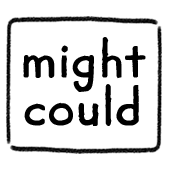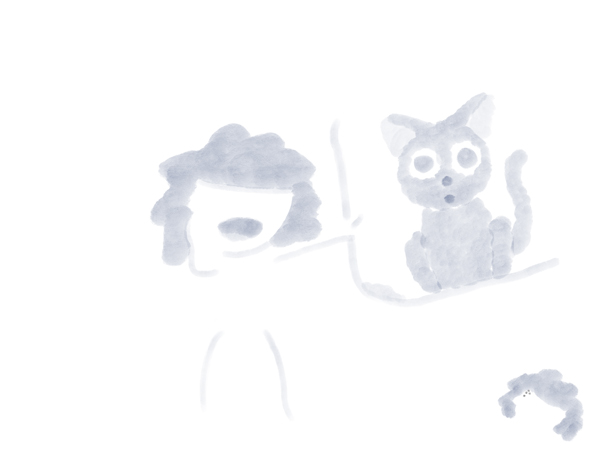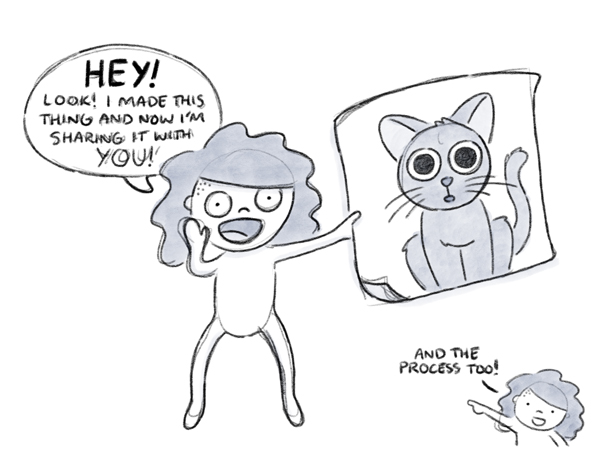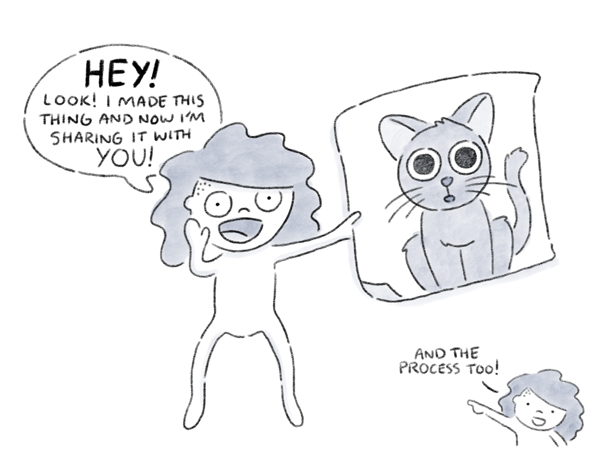
I recently watched a talk by Austin Kleon from the first Creative Mornings event in Austin, Texas a few years ago. At the time, Austin was working on his new book, Show Your Work!, which is about something I’m very passionate about—the process of creating and the sharing of that process. I’ve been sharing my process work and unfinished pieces online since I started my first blog back in 2007, but in the past year, I’ve started really sharing. I’m sharing much more now than I would have been comfortable with before. And with all that sharing, I’ve found some big benefits from sharing your work.
Some artists (I’m looking at you, writers!) warn against sharing your process, saying that if you show unfinished work you are misrepresenting yourself, opening yourself up for criticism/judgement, or even that you’re teaching other people to do what artists do and therefore bringing more competition into the creative market.
I don’t agree with any of that.
All my work, in-progress or not, is a representation of me. I actually believe the exploratory work is probably more of a representation of the true me than the final work anyway. And all work invites criticism and judgement. Sorry, but yes, if you share something, someone out there will probably not like it. Oh well. And having a scarcity mindset about the creative world is really not conducive to a creative environment in my opinion. Art is for everyone, and art making is ESPECIALLY for everyone. Be confident in your skills and you-ness to know there’s room here for everyone.
Here are some benefits I’ve experienced from sharing my work, and a few actionable steps you can take to get right to it. Let’s jump in!
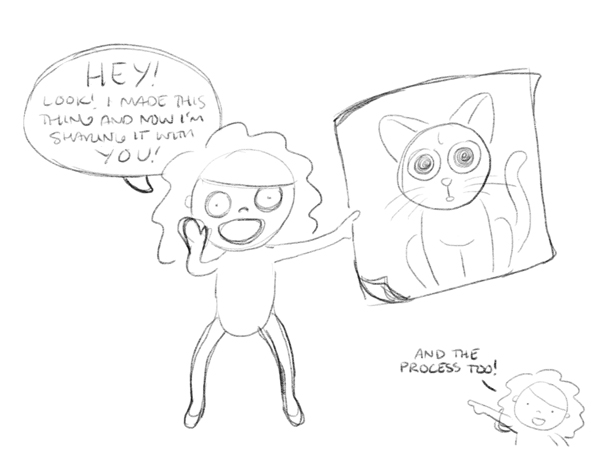
Sharing shows the reality of art making
Contrary to what a lot of people seem to think, the process of making art does not involve a strike of brilliant lightning that immediately leads to a beautiful piece. It’s a process of trial and error; just getting in there, making mistakes, learning from those mistakes, choosing which mistakes are worth keeping around, slowly progressing, and maybe eventually having a strike of insight that came about precisely because of all the prior work you put in.
Creative work is sort of like parenting—it’s a hard, dirty, and sometimes frustrating process that usually gets portrayed with a heavy dose of romanticism.” –Austin Kleon
Sharing process work shares the reality of making art—the pre-work, the quick test sketches, color studies, testing, thrown out drawings, experimenting, and exploring. What did it really take to get to that final piece?
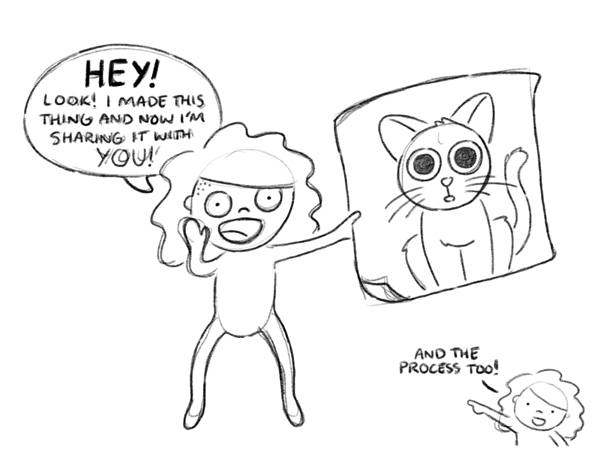
Sharing helps everyone grow
So much of what I’ve learned has come from other artists being open about their process online. I’ve taken classes where well-known illustrators shared their process and techniques, read FAQs on illustrators’ websites detailing their favorites tools and work flows, and blog posts of work-in-progress letting me peek into their steps of creation.
Sharing your process helps everyone learn and progress together. To me, it shows trustworthiness, honesty, generosity, and a pure love for what you do. I’m beyond thankful to all the illustrators that have unknowingly helped me in my career. I want to continue to be a part of that community evolution, and throw my own process into the mix so we can all continue to learn from each other and grow together.
Sharing teaches you about your own work
When I first began sharing my work, I was afraid to share my process work. I only posted final pieces, the work I thought was my best work. But occasionally, I would post a sketch or process shot. And guess what? People responded way more when I shared that process work, than my final work!
Now, to be clear, I’m definitely not suggesting you make your artistic decisions based how many likes or comments your post gets on social media. BUT. I do think sometimes it can give you clues on what’s working on what’s not. At its base level, a like/share/comment is a human responding positively to your work. They get it and can relate to it.
And this was a really important part of starting out for me… I could kind of learn in public. And then, when I started posting a lot of my own work, I tried to blog a lot about my process…I wanted people to see my thinking on the page, thinking that was often messy. –Austin Kleon
What I realized at that moment (it was actually a series of moments, because I’m hard headed apparently), is that the work I thought was best—my final work—was not speaking to people as much as my process work was. So I began to ask myself: Why?
A lot of artists think sharing their work is merely a matter of putting it where people can see it, but sharing really means opening up and having a relationship with your audience, letting them talk back to you and work alongside you, and learning something from them. –Austin Kleon
That led me to a problem with my work that artists encounter all the time. I was losing the liveliness and vitality in my sketches when I refined them into a finalized piece. I was doing too much, messing with it too much, beating it to the ground, trying to make it look good, and losing whatever original spark of life the idea had in the beginning. So I learned from that lesson, began sharing more process work, and now try to consciously focus on keeping the original vitality from my process work in my final pieces.
Sharing helps you focus on the process, not the final piece
I’m gonna argue something crazy here. I think there’s more value in the process of making art than in the final piece. I think I probably get more value out of making a piece of my art, than you (the viewer) get from looking at it. For me, making art is a process of self-discovery and self-awareness, and it would be a lot to ask the viewer to have that same kind of experience looking at my work.
But that’s ok! I’ve found that by recognizing the importance of the process, committing to the process, and sharing that process, it makes my final pieces stronger. My final art has more depth, and that sense of my self-discovery can shine through. And maybe one day, if I keep focusing on the process, my work will encourage a sense of self-discovery in the viewer too.
Last year, I was reading my friend Mike Monteiro’s great book, Design Is A Job, and there’s this bit about explaining design work to clients, where he writes, “This isn’t magic, this is math. Show your work.” –Austin Kleon
Focusing too much on the final artwork while creating is paralyzing. You can’t know what the final work will look like when you begin. So don’t worry about it. Focus on the process, the mark making, and the exploration. If you’re able to focus on that, the liveliness will carry through the whole piece.
Sharing helps you reflect on what you’ve accomplished
There are few things I love more than looking back on the process of a project. It could be a time lapse video of a drawing from my iPad, looking through folders of sketches and character explorations for a book, flipping through a stack of manuscript revisions, or clicking through hashtags I’ve started to document projects. I love it.
So often we artists are too hard on ourselves. I do it all the time. I’ll draw something, it will look bad, and I’ll feel bad. I’ll struggle with a drawing in my sketchbook, a story revision, or project planning, and I’ll get a heavy dose of self-consciousness and doubt about my skills. It’s natural to have those feelings. But in order to not let them take over, and to stop ourselves from quitting, or believing in that voice that tells us we’re bad, we need to have a voice that tells us we’re good, too.
Most artists know that their work is really a never-ending, evolving process, full of ups and downs. And yet, most artists only choose to share their perfect, finished products. –Austin Kleon
Looking back on my process work is that voice for me. When I look back on a timelapse video or a pile of sketches, I get a giddiness and excitement from reliving the process. I can remember how I felt while I was drawing it (ie. I was completely unsure of where it was going) and then watching as a third-party viewer where it went and how it developed is thrilling!
I’m sure to some people this may come off as sounding egotistical. But first of all, I don’t feel this way about everything I make. Trust me, I make plenty of things that start out bad, keep being bad, and end up bad. But when I do make something I like, and have a moment of pride, I don’t want to squash that. I want to recognize that pride and use it to combat the negative inner critic that’s always there.
Looking back at my process after I finish a piece allows me to reflect on what I’ve accomplished, even if the only accomplishment that time was that I made something. That’s worth celebrating too. This sense of pride in what I make and a commitment to the process encourages me to keep drawing and keep making.
Actionable steps to start sharing more
- Start sharing sketches/under-paintings/first drafts/etc.
- Write a blog post detailing your process of making what you make.
- Pay attention to if people respond to certain aspects of your work more than others. Think about what that could mean.
- Take pride in what you make, and give yourself credit for the work you’ve done. Celebrate what you made!
- Start a hashtag for a project you’re working on to document the process (I share process shots of my picture book, We Are Fungi, on Instagram with the hashtag #MightCouldMushroom, and my process of learning to draw loosely with markers under #MightCouldCopic).
I hope you decide to share more of your work and more of your process! What kind of process work do you already share or what do you want to start sharing? Let me know in the comments below! :)
